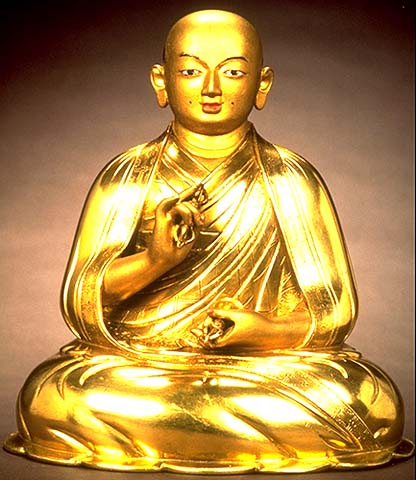
Choijin-Lama Temple Museum
<< previous image || Mongolian Exhibition || next image >>
Portrait
of Zanabazar
School of Zanabazar
Late 17th-early 18th century (or later)
Gilt bronze with silk cushions and cloak
H (of figure): 26 1/2 in. (67.3 cm) W:17 in. (43.2 cm) D: 13 1/2 in. (34.3 cm)
|
Some of the earliest images of Buddhist masters can be dated to eighth century China, when portraits of Chan patriarchs were painted to memorialize the oral transfer of the dharma from one master to the next. These portraits were set up in patriarch halls and used in rituals that resembled Confucian ceremonies to honor the dead. For the Chinese, such lineages also established the political legitimacy of certain masters over others, and their right to control the growing wealth of the Chan monastic community, much as an imperial dynasty derived its authority from inheritance.(1) Tantric Buddhists also emphasized the importance of lineage, because they believed the only sure introduction to tantric methods was with the help of a guru, whose experience was needed to guide the initiate along a spiritually dangerous path. Thus consecrations were passed from guru to disciple, creating lines of revelation that were spun back into antiquity, to the time of Shakyamuni himself.(2) These lineages of spiritual descent were reinforced in Tibet when the concept of reincarnation was first introduced in the fourteenth century. Incarnate lamas not only possessed the authority gained by studying with established adepts, they embodied the idea that the Buddha's doctrine was passed on even without instruction, transcending death. Tibetan Buddhists also memorialized their masters in painted and sculpted form from a very early period. Some of the first images of this genre are from Kharakhoto, the Tangut, Tibetan-inspired site in modern Ningxia province (China) that was overrun by Chinggis Khan in 1227.(3) The genre of portraiture continued to occupy some of Tibet's best artists in ways that the making of icons could not; the best Tibetan portraits are psychologically insightful, seemingly true to life, and convey a strong sense of the presence of the master.(4) As the first and greatest incarnation of Outer Mongolia, Zanabazar was the subject of many portraits in media ranging from the humble woodblock print to sumptuous gilt bronze (see also cat. no. 16). This gilt bronze image of him is one of several major representations still surviving in Ulaanbaatar (others are in the Bogdo Khan Palace Museum, see Rossabi, "Mongolia: From Chinggis Khan to Independence, fig. 9, and at Gandantegchinlin), and a mold to make a smaller scale, but identical sculpture of him (cat. no. 114) suggests that his image was widely proliferated. Here the first Bogdo Gegen sits in his elegant monk's robes, with his legs folded beneath them. He holds the two attributes he inherited from his immediate preincarnation, Taranatha (fig. 1), raising the dorje up to his chest with his right hand, and pointing the dorje-handled bell in his left hand toward his stomach. His wonderful, round head fits the description attributed to the Kangxi emperor's mother when she first glimpsed him through a glass window and said, "This Blessed One of yours is a beautiful lama, like the full moon."(5) Though intended to be seen only from the front and then only when clothed in a Tibetan-style nab-sa (mantle), Zanabazar's back is beautifully sculpted into a fan of regular, rounded folds. He presently sits ensconced on a square dais, backed by an aureole decorated with a pair of upswept crocodilian makara. Zanabazar's flat cushion and back rest are like the stacks of pillows high lamas sit on while presiding over religious ceremonies, suggesting that this portrait of him was taken from life. (in fact, both this figure and other similar ones have been called self-portraits, probably mistakenly.) Aleksei Pozdneyev writes, however, that the first portrait of Zanabazar was not made until 1798, when the Fourth Bogdo Gegen visited Amarbayasgalant Monastery, which had been built by the Yongzheng emperor (r. 1723-35) specifically to house Zanabazar's remains. There the Fourth Bogdo Gegen had the suburgan (reliquary) housing his predecessor's embalmed body opened and ordered his best artists to paint a portrait of the corpse. This portrait Lokesh Chandra, Buddhist Iconography, especially nos. 1192 ff. |
|
Footnotes: 3. See, e.g., Robert Thurman and Marylin Rhie, Wisom and Compassion, cat. no. 91, p. 255. back 4. Ibid, cat. nos. 88, 89, 98, 100. back 5. Charles Bawden, The Jebtsundamba Khutukhtus of Urga, p. 52. back |